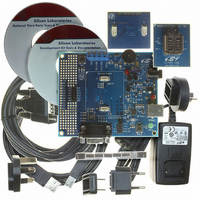C8051T600DK Silicon Laboratories Inc, C8051T600DK Datasheet - Page 7

C8051T600DK
Manufacturer Part Number
C8051T600DK
Description
KIT DEV FOR C8051T60X MCU'S
Manufacturer
Silicon Laboratories Inc
Type
MCUr
Specifications of C8051T600DK
Contents
Evaluation Board, Power Supply, USB Cables, Adapter and Documentation
Processor To Be Evaluated
C8051T60x
Interface Type
USB
Lead Free Status / RoHS Status
Contains lead / RoHS non-compliant
For Use With/related Products
C8051T600, C8051T601, C8051T602, C8051T603, C8051T604, C8051T605
Lead Free Status / Rohs Status
Lead free / RoHS Compliant
Other names
336-1404
7.1. System Clock Sources
The C8051T60x devices feature a calibrated internal oscillator which is enabled as the system clock source on
reset. After reset, the internal oscillator operates at a frequency of 24.5 MHz (±2%) by default, but may be
configured by software to operate at other frequencies. Therefore, in many applications an external oscillator is not
required. However, if you wish to operate the C8051T60x device at a frequency not available with the internal
oscillator, an external oscillator source may be used. Refer to the C8051T60x datasheet for more information on
configuring the system clock source.
The main board is designed to facilitate the use of external clock sources. To use an external CMOS clock source,
the clock can simply be applied to P0.3. To implement the RC mode option, placeholders for an 0805-packaged
capacitor (C20) and resistor (R18) are supplied on the board. The C (capacitor) clock option can be implemented
by using only the capacitor placeholder (C20). To reduce the amount of stray capacitance on the pin, which could
affect the frequency in either RC or C mode, resistor R12 can also be removed from the board when using C or RC
mode. Refer to the C8051T60x datasheet for more information on the use of external oscillators.
7.2. Switches, LEDs and Potentiometer
Two switches are provided on the main board. Switch RESET is connected to the RESET pin of the C8051T60x.
Pressing RESET puts the device into its hardware-reset state. Switch P0.3 can be connected to the C8051T60x’s
general purpose I/O (GPIO) pin through header J3. Pressing Switch P0.3 generates a logic low signal on the port
pin. Remove the shorting block from the J3 header to disconnect Switch P0.3 from the port pin.
Four LEDs are also provided on the target board. The red LED labeled PWR (D4) is used to indicate a power
connection to the target board. The red/green LED labeled D2 is the run/stop light for the debug circuitry. The red
LED labeled D7 indicates when the VPP programming voltage is being applied to the device (see Section 7.7 for
additional details). Finally, the green LED labeled P0.6 (D1) can be connected to the C8051T60x’s GPIO pin
through header J3. Remove the shorting block from the header to disconnect the LED from the port pin.
Also included on the C8051T60x main board is a 10 kΩ thumb-wheel rotary potentiometer, reference number R13.
The potentiometer can be connected to the C8051T60x’s P0.1 pin through the J7 header. Remove the shorting
block from the header to disconnect the potentiometer from the port pin.
See Table 1 for the port pins and headers corresponding to the switches, LEDs, and potentiometer.
7.3. USB Debug Interface (DEBUG / J1)
A Universal Serial Bus (USB) connector (J1) is included to provide the on-board debug and programming interface.
The debug/programming interface is powered through the USB connector, but requires power to the device via the
power connector P3 to be fully functional.
Red/Green LED
Potentiometer
Description
Green LED
Table 1. Target Board I/O Descriptions
Red LED
Red LED
SW1
SW2
RESET
Rev. 0.1
PWR
none
P0.3
P0.6
VPP
P0.1
I/O
Header
J3[5–6]
J3[7–8]
none
none
none
J10
J7
C8051T60x-DK
7










